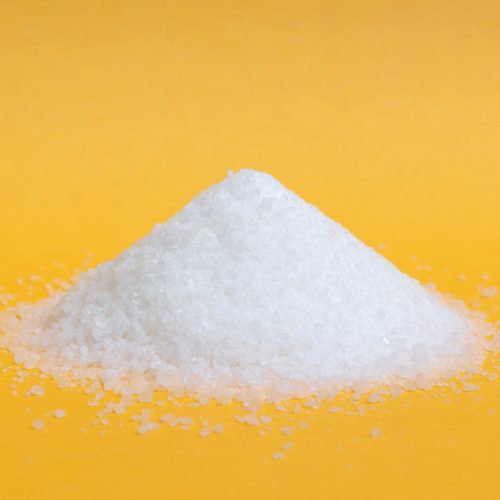
By Neva Cochran, MS, RDN, LD
December 17, 2018 — The FDA initially approved sucralose as a tabletop sweetener and for use in several desserts and beverages in 1998 and as a general use sweetener in 1999. It is produced from the disaccharide, sucrose, by replacing three hydroxyl groups on the sucrose molecule with three chlorine molecules, which makes it 600 times sweeter than sucrose. The body lacks the enzymes to break down sucralose, so most of it (85%) is not absorbed and is eliminated unchanged in the feces. The small amount that is absorbed is excreted intact in the urine.
Before its approval, FDA reviewed over 100 studies documenting the safety of sucralose. Still, myths and misinformation about sucralose continue to circulate on the Internet and social media despite scientific evidence to the contrary. This article will explore five of these and the real scientific facts to refute them
MYTH: Sucralose increases sweet taste preference.
This assumption is based on a few animal studies, as well as observational studies in humans, linking intake of low calorie sweetened foods and beverages with overweight or obesity. While animal studies are a first step in collecting preliminary data to provide future direction for human studies, animals are not humans so results from those studies cannot be applied to humans. Furthermore,observational studies do not show cause and effect but simply find that two factors in a population group are correlated.
However,interventional studies in human subjects demonstrate that foods and beverages with low and no calorie sweeteners, (LNCS) including sucralose, do not overstimulate the brain’s sweet receptors (1), do not differ in their effects on the selection of sweet foods compared to water (2), do not create differences in hunger, desire to eat and fullness (3, 4) or produce changes in satiety. (5) A detailed review of these studies can be found at https://caloriecontrol.org/the-state-of-the-science-on-sweet-taste-preference/
MYTH: Sucralose intake can lead to overeating and weight gain.
Again, observational studies correlating diet soda or LNCS intake with overweight and obesity have been used to support this claim. Cause and effect relationships are not established just because two factors are present in the same group of people . The fact that overweight individuals consume more LNCS could just as easily be attributed to a desire to reduce calorie intake for weight loss.
In contrast, randomized controlled trials have shown that LNCS may actually support weight loss, particularly as part of a behavioral weight loss program. (6) In addition, members of the National Weight Control Registry, who have successfully lost and kept weight off, consumed three times more artificially sweetened soft drinks, more water and significantly fewer sugar-sweetened soft drinks compared to a group of individuals who were never overweight. (7)
MYTH: Sucralose increases the risk of cancer.
There is no evidence to support this contention. Studies on the long-term intake of sucralose and cancer development have repeatedly demonstrated that there is no reason for concern. (8) The small amount (15%) of sucralose that is absorbed is not broken down, but rather transformed into toxicologically and biologically insignificant substances. (9)
Randomized, double-blind clinical trials with sucralose consumed daily for 3 months in amounts greater than the maximum estimated daily intake (EDI) showed no evidence of toxicity or carcinogenic potential. (9) For an average-weight adult, the amounts determined to be safe in a wide range of studies were equal in sweetness to more than 40 pounds of sugar per day over a lifetime. (10)
According to the National Cancer Institute, studies on the carcinogenicity of FDA-approved sweeteners have not provided clear evidence of an association with cancer in humans. (11) And the American Cancer Society says current evidence does not show a link between low and no calorie sweeteners and increased cancer risk. (12)
MYTH: Sucralose causes gastrointestinal problems.
The assertion is based on a single rodent study. Two groups of mice, one prone to developing a Crohn’s Disease-like ileitis and the other that was not, were supplemented with a sucralose/maltodextrin blend in their water to assess Crohn’s Disease-like ileitis and intestinal microbiome alterations. (13) Maltodextrin is used as a filler ingredient in sucralose preparations, making up 99% of the mixture vs. 1% for sucralose. As sucralose is so intensely sweet a bulking agent is necessary to provide volume.
Despite media headlines, the study did not find that sucralose worsened gut inflammation in the mice with Crohn’s-like disease but did increase proteobacteria in the stool of both groups of mice. Proteobacteria is involved in the digestion of maltodextrin, so this was is not surprising as maltodextrin is combined with sucralose as a filler. The study did not determine any clinical significance of these results for animals and certainly not for humans.
MYTH: Ingredients hard to pronounce should be avoided.
Consumers are increasingly looking for “clean” labels on packaged foods, that is a short ingredient list with familiar words that are easy to pronounce. In addition, the term refers to foods that are minimally processed, “natural” or “free from” ingredients with a negative image. (14)
Some food components like artificial colors, flavors and sweeteners are seen as “unhealthy” and “unfamiliar.” As a result, the food industry is attempting to streamline its ingredient lists and market products based on an ingredient or additive being absent from the food. (15)
Many ingredients with long, chemical names, however, are actually substances consumers are familiar with and accept with their common names. For instance, acetic acid is vinegar, ascorbic acid is vitamin C, alpha-tocopherol is vitamin E and diglycerides are a type of fat.
More important is the fact that all ingredients allowed in food products in the U.S. have been approved by the Food and Drug Administration after thorough review of evidence for safety, including LNCS like sucralose.
Putting it all together
As health professionals, our role in guiding clients, patients and consumers toward good nutrition and healthful eating is to offer choices. Sucralose and other LNCS provide a way for people to enjoy sweetened foods and beverages with less sugar and fewer calories. Theycan also help increase the intake of nutrient-rich foods like yogurt, milk and canned fruit and juice. Assuring consumers that LNCS are safe will help them enjoy foods that contain them without fear.
 Neva Cochran, MS, RDN, LD is a registered dietitian nutritionist based in Dallas. She serves as a nutrition communications consultant to a variety of food and nutrition organizations, including the Calorie Control Council. She is passionate about promoting fact-based food and nutrition information to help people enjoy nutritious eating. Follow her on Twitter @NevaRDLD and check out her blog at www.NevaCochranRD.com.
Neva Cochran, MS, RDN, LD is a registered dietitian nutritionist based in Dallas. She serves as a nutrition communications consultant to a variety of food and nutrition organizations, including the Calorie Control Council. She is passionate about promoting fact-based food and nutrition information to help people enjoy nutritious eating. Follow her on Twitter @NevaRDLD and check out her blog at www.NevaCochranRD.com.
References
- “Nonnutritive sweeteners are not supernormal stimuli” Int J Obes 39:254, 2015
- “Beverages containing low energy sweeteners do not differ from water in their effects on appetite, energy intake and food choices in healthy, non-obese French adults” Appetite 125:557, 2018
- “Aspartame Consumption for 12 Weeks Does Not Affect Glycemia, Appetite, or Body Weight of Healthy, Lean Adults in a Randomized Controlled Trial” J Nutr 148:650, 2018
- “Effects of oral ingestion of sucralose on gut hormone response and appetite in healthy normal-weight subjects” Eur J Clin Nutr 65:508, 2011
- “The Effect of Sugar-Free Versus Sugar-Sweetened Beverages on Satiety, Liking and Wanting: An 18 Month Randomized Double-Blind Trial in Children” PLOS ONE 8:e78039, 2013
- “Nonnutritive Sweeteners in Weight Management and Chronic Disease: A Review” Obesity 26:635, 2018
- “Use of artificial sweeteners and fat-modified foods in weight loss maintainers and always-normal weight individuals” Int J Obes33:1183, 2009
- “Critical review of the current literature on the safety of sucralose” Food Chem Toxicol106:324, 2017
- “Sucralose Non-Carcinogenicity: A Review of the Scientific and Regulatory Rationale” Nutrition and Cancer, 68:8, 1247, 2016
- “An overview of the safety of sucralose” Regul Toxicol Pharmacol 55:1, 2009
- “Artificial Sweeteners and Cancer” National Cancer Institute at the National Institutes of Health 2016 https://www.cancer.gov/about-cancer/causes-prevention/risk/diet/artificial-sweeteners-fact-sheet#q2
- “Common questions about diet and cancer” American Cancer Society 2016 https://www.cancer.org/healthy/eat-healthy-get-active/acs-guidelines-nutrition-physical-activity-cancer-prevention/common-questions.html
- “The Artificial Sweetener Splenda Promotes Gut Proteobacteria, Dysbiosis, and Myeloperoxidase Reactivity in Crohn’s Disease–Like Ileitis” Inflamm Bowel Dis 24:1005, 2018
- “Consumers’ categorization of food ingredients: Do consumers perceive them as ‘clean label’ producers expect? An exploration with projective mapping” Food Qual Prefer 71:117, 2019
- “Making sense of the “clean label” trends: A review of consumer food choice behavior and discussion of industry implications” Food Res Int 99:58, 2017


